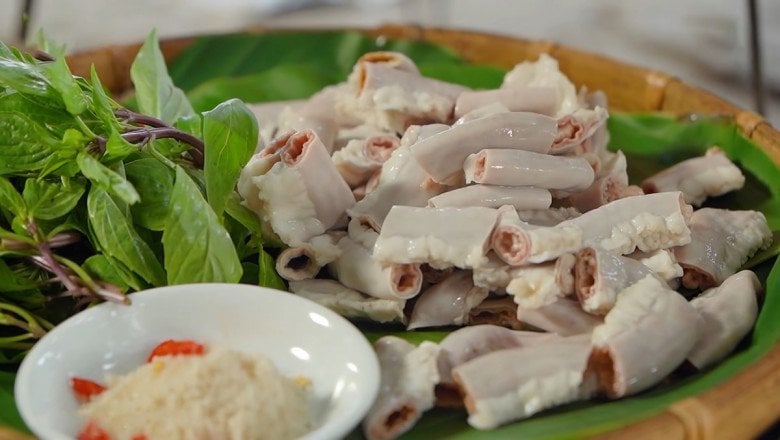Here are 6 dishes that taste even better when cooked and soaked in cold ice water before eating:
1. Making lemongrass and kumquat chicken feet
Remove the nails from the chicken feet, wash them thoroughly with cold water, then squeeze them with a few slices of ginger and white wine to remove the unpleasant smell, rinse them again with cold water and drain them. Then cut the chicken feet in half.
Bring a pot of water to a boil, add a few slices of ginger and lemongrass and the chicken feet and boil for about 3-5 minutes until the chicken feet are just cooked, then turn off the heat.
Immediately remove the chicken feet to a bowl of ice water with a little salt and soak for 10 minutes.

Remove the chicken feet from the ice water after 10 minutes, drain them and wrap them tightly with plastic wrap and refrigerate for 20-30 minutes to make the chicken feet crispy. Wrapping the chicken feet tightly before refrigerating will prevent them from drying out and make them crispy.
Then pour off the water the chicken feet were soaked in and transfer the chicken feet to a bowl of lemongrass and kumquat water to marinate until ready to eat.
2. Boiled pork leg, firm and crispy
Boiled pork leg, firm and crispy, thinly sliced and eaten with vermicelli and shrimp paste is always a favorite of many people. It is also a delicious dish in the meals of many families.
Clean the pork leg, tie it up and put it in a pot to boil over low heat, add some crushed ginger and onion for flavor. After 15-20 minutes, insert a skewer into the meat and if no pink juice comes out, the pork leg is cooked, remove it and immediately immerse it in a bowl of cold ice water to cover the meat.

Pork leg after boiling, soaking in ice water will be whiter, firmer and more delicious. (Photo by Bui Thuy)
Soaking in ice water will cause a rapid thermal shock, which will make the skin of the pork leg shrink and become crispy, while also preventing the evaporation of moisture from the inside, making it whiter. Then, pat dry and refrigerate to help the meat become firm and easier to slice thinly. This method can also be used when boiling chicken to make the skin crispier and tighter.
3. Crispy and delicious stir-fried squid, no fishy smell
Choose fresh squid that is thick, white, firm, not mushy, and has an even brown membrane around the body.
Marinate the squid with a few drops of sesame oil or a little wine or sugar for 3 minutes then rinse, this will make the dish more delicious when stir-fried.
To make the squid crispy, blanch it in boiling water, then remove it to a bowl of cold ice water. (Note to keep the squid whole so that it does not lose its sweet flavor).

Crispy and delicious stir-fried squid, no fishy smell
Or, clean the squid, leave it whole, put it in a pot (without adding water), and heat it on the stove (remember to turn off the heat as soon as it boils). This method not only makes the squid crispy when eaten, but also makes it stir-fry very quickly. Boil a little water and blanch the squid, then remove it and put it in a bowl of ice water. The squid will also be crispy and delicious.
Then add the seasonings such as onion, garlic, pepper, sesame oil, ginger, and oyster sauce to the squid to make it flavorful and appealing.
4. Boiled pork tripe, white and crispy, delicious
Pork tripe should be chosen with a round, thin end, and a milky white color indicating that it is not bitter and tastes good. Squeeze the tripe with a little salt and lemon, then rinse it clean.
Bring a pot of water to a boil, add some crushed ginger for flavor, and add the tripe, using chopsticks to submerge it. When the water boils, the tripe will shrink, boil for 1.5 minutes, remove it and immediately soak it in a bowl of cold ice water with a few slices of lemon.

Boiled pork tripe, white and crispy, delicious
The method of soaking in cold ice water causes a sudden thermal shock, along with the sourness, which helps the tripe become white and crispy. Repeat the above process once more to make the tripe completely cooked, white and crispy, and delicious.
5. Boiled pork stomach (tripe), crispy and delicious
Similar techniques are used to boil pork stomach. Clean the pork stomach by squeezing it with flour to remove the sliminess, then squeeze it with an acidic substance (lemon, vinegar, or lactic acid, pickle juice). To remove the odor, boil a pot of water, add the pork stomach and blanch it with a little fish sauce to remove the odor, rinse it under running water, turn it inside out, scrape it with a knife and rinse it clean. There are two techniques for boiling pork stomach: the rapid thermal shock method or the slow boiling method followed by thermal shock.

Boiled pork stomach (tripe), crispy and delicious
With the thermal shock method, follow the “3 boil-4 cold” principle used by many restaurants: Bring a pot of water to a boil, add the pork stomach and submerge it, when it starts to boil again, immediately remove it to a bowl of ice water with a little lemon juice. Repeat this process three times.
For the slow boiling method, boil for 35-45 minutes, depending on the size of the pork stomach, then turn off the heat, cover and simmer for another 12-15 minutes. Then, remove it and put it in a bowl of ice water with lemon. This dish is best served with herbs and pure fish sauce with a little chili, pepper, and shallots.
6. Boiled pork ear, white and crispy, delicious
When you buy pork ear, use a razor blade to scrape off the hair around the ear and the dirt inside. Then, to remove the smell of the pork ear, rub it with half a lemon and rinse it with diluted salt water.
Finally, to prevent the pork ear from turning brown, squeeze the remaining half of the lemon into a bowl of water and soak the pork ear for about 10 minutes, then remove it and drain it.

Boiled pork ear, white and crispy, delicious
Place a pot of water on the stove, bring to a boil over high heat, then add thinly sliced ginger and a bundle of lemongrass. Then add the pork ear, add 1 teaspoon of MSG and boil over medium heat for about 30-40 minutes, then turn off the heat.
To make the pork ear white and crispy and prevent it from turning brown, prepare a bowl of cold ice water, after the pork ear is cooked, remove it to the bowl of ice water immediately. When the pork ear is completely cool, remove it and slice it thinly.







































